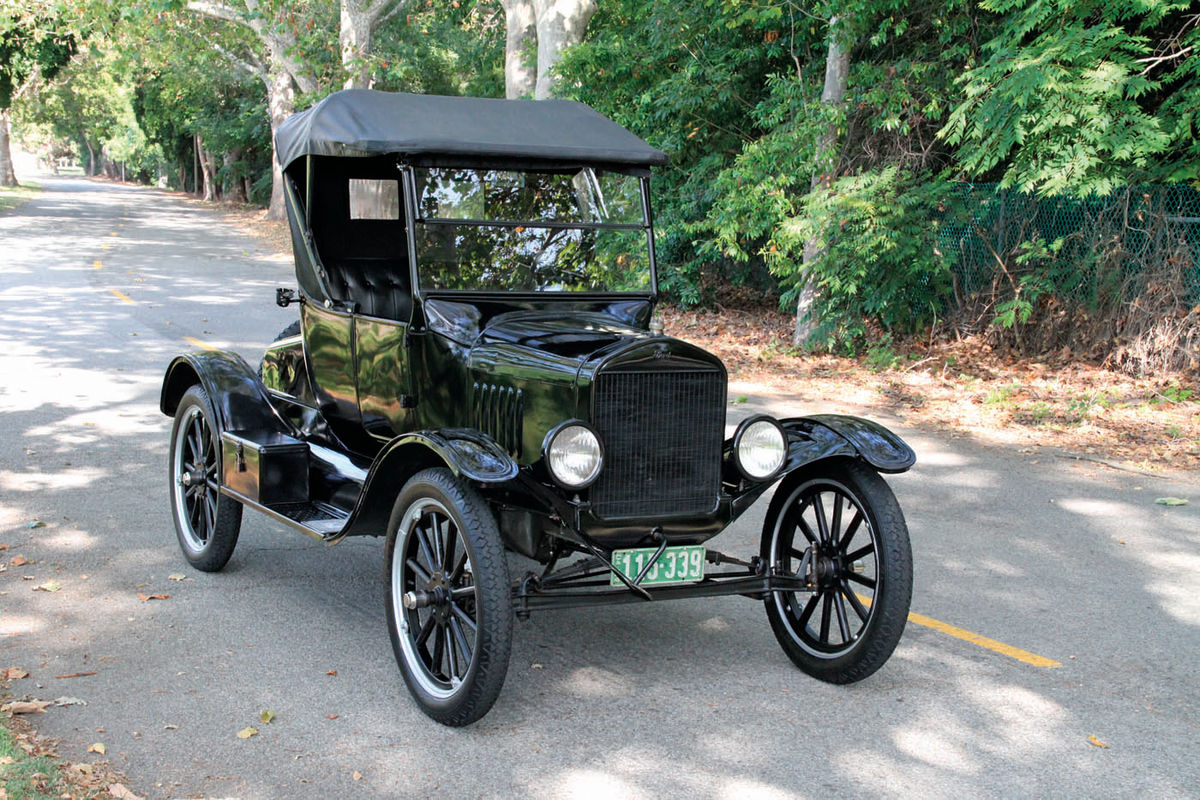DRIVING A 1924 MODEL T ROADSTER
You’ll Quickly Find That It’s Not Like Other Cars You’ve Driven. Expect to Become Very Involved Before and After You Hit the Road.
ANY MODEL T Ford is very impressive when you consider what it doesn’t have…and yet it was the most successful American car of all time. It doesn’t have a fuel pump, water pump, oil pump or oil pressure gauge, temperature gauge, fuel gauge, speedometer, odometer or even a dipstick.
In fact, the only gauge on the dash of Andria Myers’ 1924 Model T seen on these pages is an ammeter, and even that was an extra-cost accessory that was a virtual necessity if you had the self-starter instead of relying on a hand crank. Henry Ford did not think you needed any of the potential additions, and truth is; you actually didn’t. Not if you did the proper checks before starting the car, and then kept an eye on things while driving.
Prepping for a Drive
Before starting out, you would want to first check the water level in the radiator; and yes it takes nothing but good old aqua pura, not “coolant.” And while driving, a fair amount of it evaporates out of the system. Next you would check the oil level in the crankcase and transmission. To do that you need to reach under the car where there are two petcocks. You first crack the upper one, and if a little dribble of oil comes out, you are fine. But if no oil comes out, you crack the lower petcock. If oil runs out you are still OK, but if it doesn’t, you need to add some, up to the level of the top petcock.
You would then want to check how much gasoline you have, and you do that by lifting the front seat lower cushion and unscrewing the gas cap on the 10-gallon tank underneath. You would next insert a wooden ruler marked off in gallons and fractions of gallons. The fuel level is determined by how much of the stick is wet when you pull it out.
Once these checks have been performed, you are ready to get in and start the car. You get in on the passenger side because that’s where the door is. What looks like a door on the driver’s side is just a bead in the sheet metal. Henry reasoned quite correctly that two doors were an unnecessary extravagance. Besides, the combination parking brake lever and high gear clutch, which is a lever two feet tall, would have made entry a bit undignified on the driver’s side.

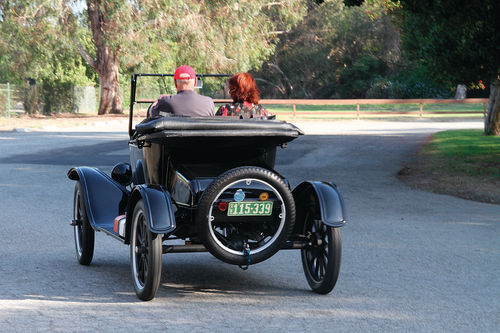
We’re Still Prepping for Our Drive…
Actually, one doesn’t get in a Model T. One climbs up onto it. The seating is comfortable, and adequate for two, and the headroom would allow a six-footer to wear a top hat, and even doff it at the ladies while driving along. There also is plenty of legroom, and the two-piece ventilated windshield is like looking out a picture window.
By 1924 most Model T Fords had electric starters on them (they were first made available on Fords in 1919). But you could still order the car without one if you didn’t desire such indolent decadence — in which case you would have to start the car with the hand crank up front. Of course, even if you have the self-starter, you can still easily crank-start the car. But in that case its unique ignition system works entirely differently, though it accomplishes the same thing.
In any case, you first open the petcock in the carburetor fuel supply line. Then you make sure the ignition is off, set the emergency brake, pull the choke out a little bit, and go around and crank the engine three or four times to prime the cylinders. After that, if you are hand cranking the car, you turn on the ignition, and then with your left hand cupped over — but not gripping — the crank you just bump the engine over. You want to use your left hand because of the clockwise rotation of the engine. If you use your right hand and the engine backfires, it could break your arm. A Model T will usually start with one or two bumps. Then you step around and adjust the spark and throttle until the engine idles smoothly.
Contrary to what some might think, Model T Fords aren’t typically hard to start with the crank if they are in reasonable tune. The low compression ratio of 4.5:1 means the engine turns over pretty easily. After you have the engine running you merely retard the spark and set the throttle lever for low rpms and you are ready to depart.
Starting Our T the “Easy” Way
To start Myers’ Model T using the electric starter, I give the carburetor a little choke, pull the spark lever to full retard and push the throttle lever open just a bit. Then I turn on the ignition switch, which causes the four tickler coils under the dash to make sounds like a hive of furious bees. I then step on the starter button in the floor in front of the seat. The engine turns over a couple of times and coughs to life with a clatter of valve train noise and a puff of blue smoke.
I advance the spark lever and back off on the throttle until the engine goes into that regular “chitty-chitty” sound so typical of early cars. (It only goes “bangbang” when you get the spark wrong and make the engine backfire.) You can actually throttle the old Ford down to where you can discern each cylinder firing in turn, but that is not recommended for any length of time because the cylinder walls, which are splash lubed, will be starved for oil if you do so.
All Model Ts from 1909 until 1927 when production ceased had four-cylinder, 177-cubic-inch monoblock flathead engines in them with removable heads. They also had a two-speed planetary gearbox that was a unique experience for drivers of conventional standard shift cars. In fact, it was so different that some states had one driver’s license for Model T drivers, and another for people with conventional cars.
Now Let’s Go for a Drive
I give the engine a little throttle with the steering wheel lever, make sure the hand brake is in the vertical position, depress the leftmost pedal to the floor and we are off. I take the car up to about 10 miles per hour and then move the hand brake forward. I then let up on the left pedal and we are in high gear. The little roadster seems to be very happy at about 25 miles per hour even though it will do 40 mph-plus.
When making a turn you might have to downshift, in which case you would want to depress the left pedal to the floor, and then perhaps back off on the hand throttle. The T engine is unbelievably torquey though, so you might not have to downshift unless you are negotiating a very slow corner.
Steering is light and direct because the car only weighs between 1200 and 1500 pounds depending on the model. Like most cars of the period, the steering is not self-centering, so you need to continuously point the car where you want to go. In other words, if you turn the wheel and then let go, the car won’t straighten up, but will continue turning until you tell it not to.
Braking is reasonably good provided you remember to pull the throttle lever back to idle as you do so. The brake is actually just another drum on the transmission, but it works pretty well. The small brake drums you see on the back of the car are just the emergency brake, and they have external contracting linings that wrap around small inner drums. You can apply both brakes for maximum stopping power, and in a real emergency you can stomp on all three floor pedals at once.
This will not likely damage the car on a one-time basis, though it’s not something you would want to do very often because it would burn the woven cotton composition bands in the transmission.
We had no such emergencies, and in fact puttering along the road is as pleasant a sojourn as I have ever encountered. We are perking along at hair-mussing speed and people are coming up alongside us, smiling and giving us the thumbs-up before speeding away.
We then swing into a nature preserve, pay the entrance fee and take a spin around on a nice, untraveled shady two-lane road with leafy branches overhanging; the smell of pepper trees perfuming the air. This is what a Model T was designed to do.
It Was Popular a Century Ago…and Still Is
Woodward Avenue in Detroit had the very first mile of concrete roadway in the country in 1909, so pavement was virtually non-existent in the Model T era. In fact, most roads — once you reached the edge of town — were rutted, potholed, unsealed washboard wagon tracks. And if it had been raining, hub-deep mud was the order of the day. That’s why the car has 30-inch-diameter wheels.
The Model T may look antiquated and spidery today, but it was a brilliant state-of-the-art design when it debuted in October 1908 as a 1909 model.
In fact, the T was so good that Ford continued to build it until 1927, adapting and improving it, but not changing its basic design as the years went by. In all, over 15 million of them were constructed. And in 1920, seven of every 10 cars in the world were Model T Fords. Sales topped out in 1923 with 1.9 million cars. That would be quite a feat even today. Were there better cars back then? Sure — provided you were willing to spend a lot more money. And most people in the teens and ’20s didn’t have a lot more money to spend.
Besides, the Model T was simple, durable and dependable. Those are some of the reasons there are still so many of them around today. And, thanks to the fact that they are relatively common, most parts are still available for them. Andria Myers uses her roadster as a daily driver a lot of the time. On nice days she drives it to work, and she often goes to the grocery store in it. In fact, Andria likes her 1924 Roadster so much that she’s restoring a 1923 Doctor’s coupe as well. And she’s the one who’s doing the work.
She’s the Family’s Restoration Expert
As a hobbyist who has restored some 20 cars over the years, I know when someone knows their stuff and when they don’t, and Andria Myers knows her stuff. We walked around her coupe restoration project while she pointed out what she had done, and what needed doing next.
“I just got the engine and transmission back in, and now I am cleaning and painting the chassis and front suspension,” she said. She pointed out that her coupe has the optional anti-lean coil springs, and an accessory spring to stop the steering tie rod from rattling. Her coupe has an electric starter too.
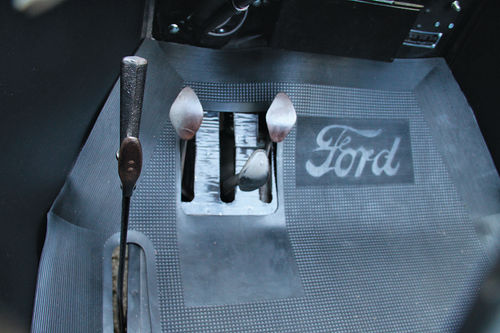
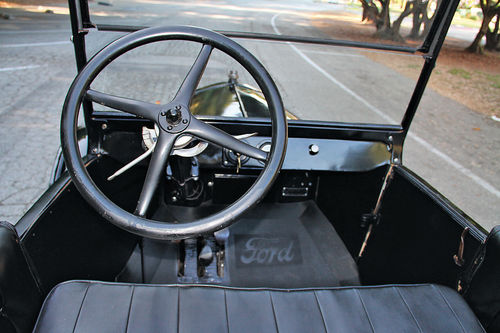
Later I met Andria’s husband Dan and asked him about the old Fords. He cut me off by saying, “That’s Andria’s thing. I don’t work on the cars.” He enjoys an occasional ride or club function, according to Andria, but that’s about it for him.
Apparently the T’s captivatingly practical, no-nonsense nature isn’t a magnet for everyone.
Henry Ford’s Approach to the Auto Business
Because Henry Ford insisted that the T be so Spartan, there were all kinds of after-market accessories available for a T and the Sears catalogs of the era were full of them. You could get overhead valve and even overhead cam conversions for the engine. Furthermore, new engines were available for the Model T up into the ’40s, or you could send your old motor to Sears and get a rebuilt for a nominal amount, shipped to you by rail. Many rural people — and there were indeed many rural people when the T was in production — knew how to work on their Model Ts and appreciated the utter simplicity that was designed into them.
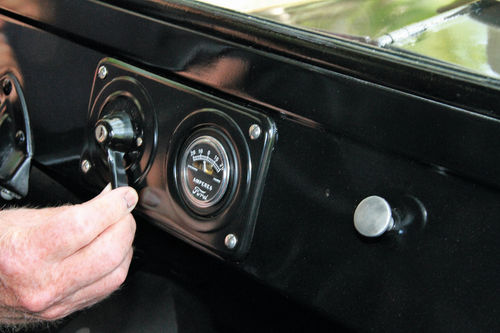

That simplicity by design came about because Henry Ford was born on a farm himself and started out fixing and selling farm machinery. He knew the challenges rural residents faced. He also knew that unless he could build the car cheaply and simply enough for farmers to be able to buy and maintain them, his market would be limited. And then, as everyone knows, he raised his workers’ wages to the then princely sum of five dollars a day so they could buy Fords too.
Furthermore, at the Ford plant Model Ts were built on the industry’s first moving assembly line where build tasks were broken down into simple repetitive steps that required practice but little or no skill to perform. This orderly organized approach translated into huge cost savings, and it meant that a new Ford could be assembled in 96 minutes, start to finish! Today, all but a few astronomically expensive handbuilt exotic cars are made on an assembly line.
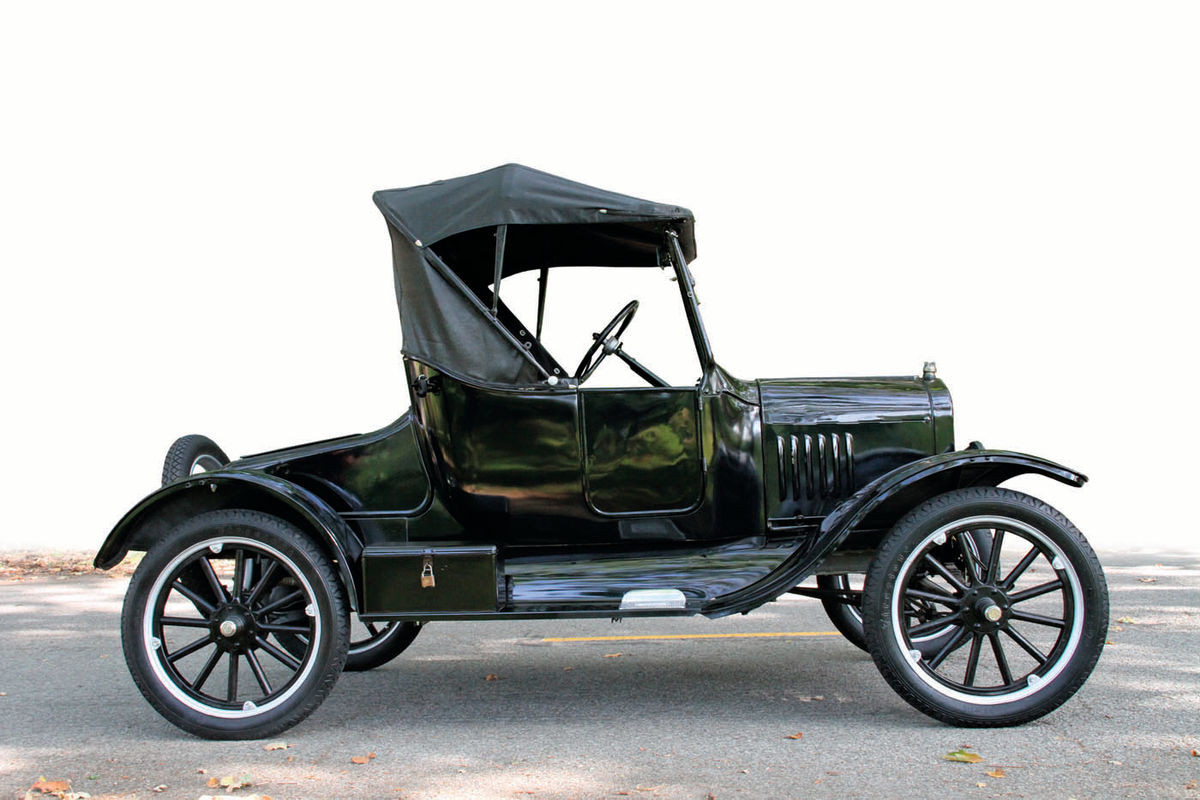
As for Henry Ford actually saying the customer can have a Ford “in any color he wishes as long as it’s black,” the story is probably apocryphal, but Ford did mandate that all Model T Fords be painted black from 1913 until 1926. That way the paint was easy to match from component to component, and black paint dried quickly and held up the best. It had nothing to do with the method in which it was applied, because some components were dipped, others painted with brushes, and later other parts were sprayed.
Another interesting thing about the Model T is that it was designed to run on gasoline or alcohol. And, in fact, it could even run on kerosene if properly warmed up. But Prohibition and a cheap, abundant supply of gasoline meant that very few owners used alternative fuels.
Now, Let’s Get Back Behind the Wheel
We roll along through the nature preserve at a sedate pace and enjoy being out in such a bucolic environment with the vintage car’s top down. There is something very enjoyable about going places slowly and soaking up the sights, smells and sounds around you. I envy the folks who drove these cars originally because they used them often to take meandering Sunday drives after church in just such surroundings. They usually packed a picnic lunch and made a day of it.
Fact is, in the Model T Ford era very few people drove back and forth to work in automobiles. Farmers used their cars to go to town on Saturday and church on Sunday, and to visit friends and family. People who lived in town mostly walked to work or took a trolley. Occasionally people took longer trips in Model T Fords, but usually, if they were going a great distance, they took the train.
Noise, Vibration and Wheel Tramp
A Model T talks to you while it is running along. The engine makes its valve train and bearing sounds, and the transmission and rear end make their own whirring rumbling noises thanks to their straight-cut gears. There is a certain amount of rattle and vibration in general as well because the crankshaft has no counterweights, and there are no rubber motor mounts, but that only gets teeth-chattering when the engine is pushed to its red line of about 1600 rpm.
We come around a corner and hit a bump. This sets off a bit of shimmy and wheel tramp across the solid front axle. I suggested new kingpins and bushings and Ms. Myers’ explained in detail what she had done so far to correct the problem. (Wheel tramp causes the front wheels to bounce up and down alternately so the front wheels kind of walk down the road like Charlie Chaplin).
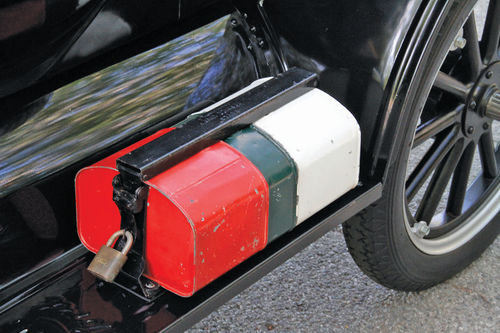
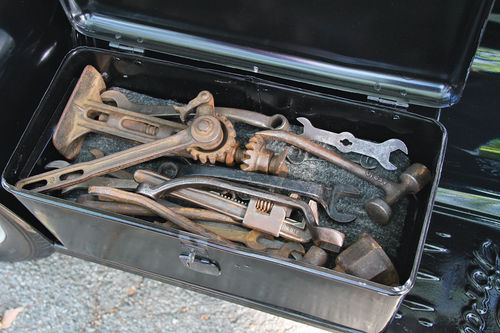
“One of my very first projects on the car was a huge one,” Andria said. “Truly a baptism by fire — jumping in with both feet — dressing the axle (the wear on the upper and lower ears was really bad), replacing the kingpins & bushings (which required some custom work on the lathe), spindle arm bushings, straightening the tie rod, and replacing the tie rod and drag link caps. The wishbone cap was replaced with an adjustable Apco type cap and shim because it had a lot of play. Next there was play in the steering column and pitman arm so the steering column was turned on the lathe (it had a huge track worn in it), the bracket was honed, and a custom steering column bushing turned for it. The alignment was adjusted.
“Recently I had suspected that the front left shackle was frozen (and indeed it was) so this past weekend the front shackles and bushings were replaced, I inspected the cross-member for hole wear or cracking, put in a new spring cushion and also put in a different front spring set to see how it behaves.” Possibly just a little more tweaking will solve Andria’s problem completely.
The Industry Moved On
By 1926 sales of the Model T were falling dramatically, even though the T got a mild restyle and was offered in various colors again, as it was in the early days. The Model T era finally ended in mid 1927 so Ford could retool for the new Model A. But the new Model A still had a four-cylinder flathead engine a little larger but very similar to the one in the T, even though it was hooked up to a more modern H-gate transmission. Suspension and steering remained essentially the same as the Model T.
As for the opposition, in 1929 Chevrolet debuted a smoother, more powerful and more modern six-cylinder engine, a modern driveline, more sophisticated suspension and handsome styling based on the Cadillac. Although the Model A remained popular, even in the face of Chevy’s onslaught, it was seen as a bit behind the times and only lasted four years.
In 1932 Ford trumped the low-price field by offering a V-8 for the mass market. After that, Ford and Chevrolet were locked in a sales battle that lasted into the 1960s, with Plymouth running a pretty consistent third.
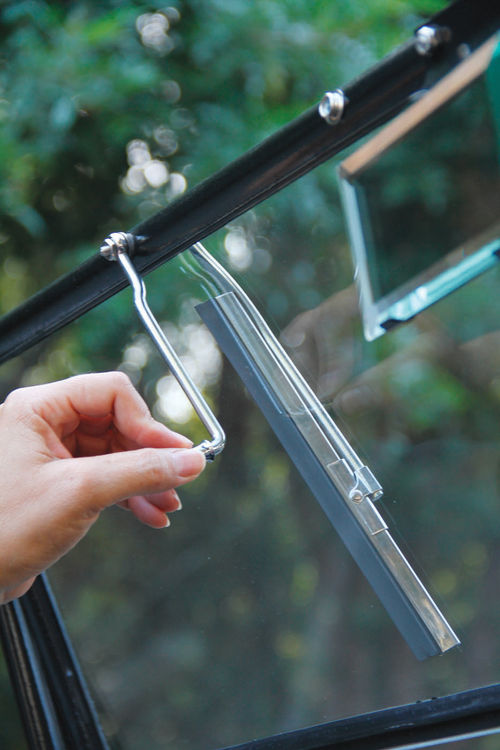
But Driving a T Can Still Become Habit-Forming
Driving around the nature center in Andria’s Model T was a magical experience, but it was getting late. We needed to get this 90-year-old machine back home soon because we would probably not be able to hold our own in rush-hour traffic at twilight with just one tiny taillight on a slow-moving black car.
Still, the whole experience was such fun that I have started checking eBay to see what it would cost to have my own Tin Lizzie, the car that put the world on wheels.
Editor’s note: If you have a Model T in your garage, used to own one or had experiences with a friend’s T like Jim Richardson did, we’d like to hear your T stories and share them with our other readers as well.

